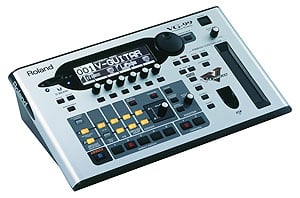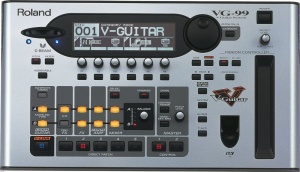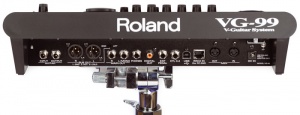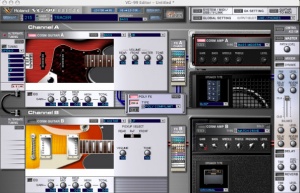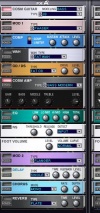Roland VG-99
Contents |
General Information
Original Author: Staffay
Weapon: Guitar/Amp/synth COSM modeller
Make: Roland
Model: VG-99
Price: 1025€ (thomann.de)
Introduction
In order to do this review I had to do some research, and even then it is difficult to try to describe such an advanced product and all the possibilities this unit has. In fact, still after using this unit for a week, I just scratched the surface of what it really can do. Roland has put all their effort, experience & knowledge from their technology, resources etc. in one state-of-the-art box, that is supposed to be the flagship of the coorporation in guitar technology.
This is NOT a guitar synth, even though it has some built-in synthesized sounds, it is built on a technology Roland is calling "COSM" (Composite Object Sound Modelling). It models different guitar/amps/other stringed instruments through the technology of HEX-pickup systems, which is the same as guitar-synth technology though. It builds on that every string has its own pickup, rather than 1-pole/string that makes up the total signal. Therefore, every string can be manipulated individually in the unit - which gives a lot of of options. It supports Fender's "Roland-ready" guitar as well as HEX-pickup compatible guitars from Godin, Brian Moore etc. It also must be mentioned that the unit can be used without a HEX-pickup, a "normal" guitar will do, but then just the effects and the amp-modelling is available.
This unit is the new version of the VG-88 that was first released in 2000, that in turn was the successor to VG-8 released in the mid 90's. Several improvements have been made since then, and the VG-99 is now a fully fledged modelling system with stunning opportunities.
Product Description
The unit is non-rack standard even though it can be rack-mounted with some additional mounting parts. Roland suggests that the unit shall be used on a stand instead, which is really a good idea, when it comes to controlling the unit via the D-Beam and the Ribbon-controller. (the former versions were floor-based) The only drawback here is that in order to take full advantage of the unit, a stand + the FC-300 controller and a HEX-pickup + cable also must be purchased. (which will add some 500-600€ to the prize above, the FC-300 controller is about 300€ alone)
Top view:
All of the unit's parameters/knobs are located on the top of the unit and are logically placed. It also features the Ribbon-control and the D-Beam. The input from the HEX-cable also goes here as well as the on/off button. The display is good and is clearly visible even in bad light. It has shortcuts for pre-programmed "chains" of sound as well as a visible tuner.
Rear view:
On the back of the unit go all different connectors, which are quite a few. Nothing is really missing here. There is even a digital out as well as balanced outputs, USB to computer (which is really great) and MIDI in/out that can be used for controlling the unit/send the signal to guitar-synths/computers etc.
Sound Engine:
The unit has two independable signal paths, which in turn gives that two totally separate instruments/amps/synths can be played at the same time. These can be layered/splitted by strings/dynamic controlled or combined in several ways. It features nearly all kinds of electric guitars/basses, amps and acoustic instruments like 12-string, nylon, sitar, banjo, mandolins etc. + a synthesizer section with GR-300 sounds & more.
The D-Beam controller: This is - along with the Ribbon-controller - the "welcome-to-cyberspace" feature of this unit. What it actually is, it's a light sensitive sensor that can be manipulated by Your hand (or other part of Your body) to control any of the parameters in the unit. (see videos down below) Eg. it can be used for freezin a tone/chord, manipulate the pitch, adding vibrato/harmonics, control the volume and a lot of other things.
The ribbon controller:
This one very much does the same job as the D-Beam, but in greater detail, as You move Your finger on the touch sensitive ribbon, You affect the parameters.
In use
To start to use this unit, the calibration of Your guitar/HEX-pickup must be made, but it's really easy-as-a-pie if You just follow the manual, and in 5 minutes You are up and playing - and probably will be sitting there for several hours as I did. Changing the parameters is really intuitive, and combined with an excellent manual it's a breeze even for a non-technical guy to manage.
The unit comes with a lot of pre-programmed good sounds (200 actually), which will suit most players, even though the most exciting part is to make Your own. I found metal sounds, 70's sounds, strat sounds and even L4 old-school-jazz sounds that all sounded very good, with a reservation of the dynamics on the clean sounds. (which seems to be the problem of all modelling amps, but still, this is the best I experienced yet)
There are plenty of possibilities when hooking up the unit to different sound systems both live and in the studio - You can have a processed sound with reverb/delay for live use and at the same time record it dry, just to name one.
To make a preset is as simple as choosing a guitar, choose pickup combination, choose an amp (or none) and then make the effects settings. Of course, all parameters here are adjustable on the amps/guitars/ and there is also a rack of "stomp boxes" -effects to add. I found the included computer-editor much more convenient to use than struggle with the on-board controls, but that is really a matter of taste since both ways work excellent.
The effects section sounds really similar to Rolands/Boss range of pedals (some of their new stomp-boxes are also featuring the COSM-technology), the reverbs & delays are excellent for live use and even in a recording situation - but I will say that a studio reverb/delay used on the dry signal will be even better. But hence - this would be as asking for too much....
One of the most outstanding features is to use custom tunings since the pickup-system allows every string to have its own tuning. You can use slide-tunings, open G, drop-d and then switch to a regular tuning in the middle of a song for a solo. Only imagination is a limit here.
Another nice thing I noticed here is that with the COSM-modelling, the pickup works like a "regular" pickup - eg. it captures string noise, artificial harmonics etc. in contrast to what a normal guitar synth doesn't do. It actually feels exactly like playing a real guitar with a real amp, even though it's kinda weird to play on an electric guitar with a mandolin sound..... Also the triggering is superb, I can't notice any delays, at least not with my playing style.
Sound
The electric sounds are just simply amazing, especially the distortion ones. It really sounds very close to the guitars/amps modelled, even though some people would prefer the originals instead of a modelling amp. But I rather see this as a matter of taste than an actual lack in the product itself.
The acoustic sounds are good - but sounds a little "piezo-like" in my ears, rather than miced with some top-notch microphones. Anyway, they will cut through in any mix and will fool most people (including myself) other than real sound-connosieurs.
Overall Impression
Im very impressed with this unit so far - there's still a lot of testing to do. Since I'm old-fashioned, I will probably stick to my old amps and guitars for live-usage, but in the studio this one is a killer. It will even save You a lot of money from buying additional guitars/amps etc. and with that in mind I consider even the fairly high prize as a bargain in terms of versatility/possibilities of use. This is really the best Roland has produced for years and must be experienced!
Guitar players have a tendency to dismiss new innovations and stick to "old" gear, but in my view, this is really the future of guitar-playing. I can't simply wait for the next generation, where the art of modelling might be BETTER than the originals. As for now I'm happy to record a nylon string that sounds awesome with my Ibanez semi-acoustic.....
Alternative Weapon
There is no alternative in this field of technology, even though there are several modelling amps out there - but they are not based on the HEX-technology.
Sound Samples



